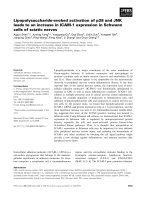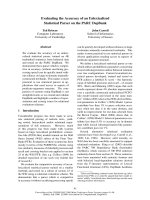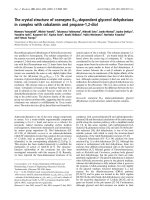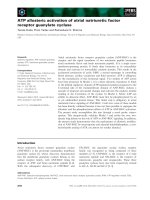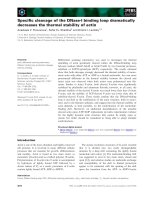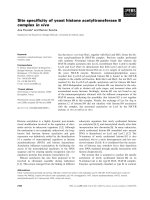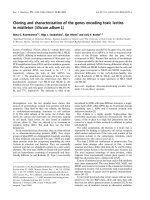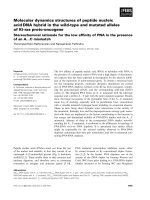Báo cáo khoa học: Stage-specific activation of MIG-17⁄ADAMTS controls cell migration in Caenorhabditis elegans docx
Bạn đang xem bản rút gọn của tài liệu. Xem và tải ngay bản đầy đủ của tài liệu tại đây (656.36 KB, 10 trang )
Stage-specific activation of MIG-17
⁄
ADAMTS controls cell
migration in Caenorhabditis elegans
Shinji Ihara
1
and Kiyoji Nishiwaki
1,2
1 RIKEN Center for Developmental Biology, Hyogo, Japan
2 Department of Bioscience, Kwansei-Gakuin University, Hyogo, Japan
The ADAMTS (a disintegrin and metalloprotease with
thrombospondin motifs) family is a group of zinc-
dependent metalloproteases that mediate a wide variety
of extracellular proteolytic events, including degrada-
tion of extracellular matrix (ECM) components, such as
proteoglycans and collagens [1–6]. The ADAMTS
family consists of 19 genes in mammalian genomes and
of five in the Caenorhabditis elegans genome. ADAMTS
members contain a signal peptide, a prodomain, a
metalloprotease (MP) domain, a disintegrin (DI)
domain, a variable number of thrombospondin type I
(TS) motifs, and additional domains near the C-termi-
nus [7–9]. The prodomain maintains enzymatic latency
of the proenzyme and is proteolytically removed to
produce the active mature enzyme [10]. Although several
ADAMTSs are activated by proteolytic processing in
the trans-Golgi network by serine proteases such as
furin [11,12], at least proportions of the ADAMTS-1,
ADAMTS-7B, ADAMTS-9 and ADAMTS-10 enzymes
are secreted as proforms and localize to the cell surface
Keywords
activation; ADAMTS protease; antibody;
Caenorhabditis elegans; MIG-17
Correspondence
K. Nishiwaki, Department of Bioscience,
Kwansei-Gakuin University, 2-1 Gakuen,
Sanda, Hyogo 669-1337, Japan
Fax: +81 79 565 9077
Tel: +81 79 565 7639
E-mail:
(Received 18 April 2008, revised 9 June
2008, accepted 25 June 2008)
doi:10.1111/j.1742-4658.2008.06573.x
The activation of ADAMTS (a disintegrin and metalloprotease with
thrombospondin motifs) family proteases depends on removal of the
prodomain. Although several studies suggest that ADAMTS activities play
roles in development, homeostasis and disease, it remains unclear
when and where the enzymes are activated in vivo. MIG-17, a
Caenorhabditis elegans glycoprotein belonging to the ADAMTS family, is
secreted from the body wall muscle cells and localizes to the gonadal
basement membrane to control the migration of gonadal distal tip cells.
Here, we developed a monoclonal antibody that recognizes the N-terminal
neo-epitope of the activated MIG-17. In western blotting, the antibody
specifically detected the activated form, the signal for which dramatically
increased during the third and fourth larval stages, when MIG-17 is
required to direct distal tip cell migration. In in situ staining, the mono-
clonal antibody recognized the activated form in the basement membrane,
whereas it failed to detect a processing-resistant mutant form localized to
the basement membrane. MIG-17 was activated in the basement mem-
branes of the muscle, intestine and gonad in the third larval stage, and
downregulated in nongonadal basement membranes in young adults and in
gonadal basement membranes in older adults. Thus, the activation of
MIG-17 is regulated in a spatiotemporal manner during C. elegans
development. This is the first report demonstrating the regulated activation
of an ADAMTS protein in vivo. Our results suggest that monoclonal anti-
bodies against neo-epitopes have potential as powerful tools for detecting
activation of ADAMTSs during development and in disease pathogenesis.
Abbreviations
ADAMTS, a disintegrin and metalloprotease with thrombospondin motifs; DI, disintegrin; DTC, distal tip cells; ECM, extracellular matrix;
GFP, green fluorescent protein; KLH, keyhole limpet hemocyanin; L, larval stage; MP, metalloprotease; PLAC, protease and lacunin; TS,
thrombospondin type I.
4296 FEBS Journal 275 (2008) 4296–4305 ª 2008 The Authors Journal compilation ª 2008 FEBS
or ECM [7,13–15]. We recently showed that MIG-17, an
ADAMTS in C. elegans with a signal peptide, prodo-
main, MP domain, DI domain and protease and lacunin
(PLAC) domain [16] (Fig. 1A), is also secreted as a pro-
form and localizes to the basement membrane of the
developing gonad [17]. Conceivably, these secreted pro-
form enzymes can be activated in the extracellular envi-
ronment to function in target tissues. However, the
timing of activation of secreted pro-ADAMTSs during
organogenesis has not been explored.
The gonad of the C. elegans hermaphrodite consists
of two symmetrical U-shaped arms formed by direc-
tional migration of gonadal leader cells called distal tip
cells (DTCs) (Fig. 1B). The DTCs are formed at the
anterior and posterior ends of the gonad primordium
of the C. elegans hermaphrodites in the first larval
(L1) stage, and start to migrate on the ventral body
wall muscle in L2. They make two 90° turns during L3
and L4, generating symmetrical U-shaped gonad arms
[18] (Fig. 1B). The spatial and temporal patterns of
DTC migration are strictly regulated by extracellular
environmental cues involving various secreted and
membrane-bound proteins [19–26]. MIG-17 is secreted
from the body wall muscle cells and localizes to the
gonadal basement membrane, where it is required for
directional migration of DTCs [16]. In mig-17 mutants,
the DTCs migrate aberrantly, causing the gonad arms
to be deformed (Fig. 1B, right bottom).
The MIG-17-dependent control of gonad develop-
ment offers an excellent system with which to study
the function of ADAMTSs during organogenesis
in vivo. In this study, we isolated recombinant MIG-17
and determined the amino acid sequence of the N-ter-
minal neo-epitope of the activated form, which is
generated by prodomain removal. A monoclonal anti-
body raised against this neo-epitope specifically recog-
nized the activated MIG-17 in vivo. We demonstrate
that MIG-17 is activated in basement membranes in
worms and that the activation is spatially and tempo-
rally regulated during development.
Results
MIG-17 is activated during development in
C. elegans
We previously showed that activation of MIG-17,
which controls DTC migration, requires removal of
A
B
CD
Fig. 1. MIG-17 is activated during larval de-
velopment. (A) Domain structure of MIG-17.
(B) Developmental stages and gonad mor-
phogenesis in C. elegans hermaphrodites.
The cartoon at the bottom right shows
abnormal gonad morphology in mig-17
mutant adults. The sizes of the animals do
not correlate with the actual sizes. (C, D)
Activation of MIG-17 during larval develop-
ment. Cell lysates from each developmental
stage were prepared from L1 to the adult
stage. Cell lysates (20 lg) from staged
wild-type worms expressing MIG-17–GFP or
MIG-17(E303Q)–GFP were subjected to
SDS ⁄ PAGE followed by immunoblotting
with anti-GFP IgG. Arrow, proform;
arrowhead, activated form; SP, signal
peptide.
S. Ihara and K. Nishiwaki Regulated activation of MIG-17 ⁄ ADAMTS
FEBS Journal 275 (2008) 4296–4305 ª 2008 The Authors Journal compilation ª 2008 FEBS 4297
the prodomain [17]. Using an MIG-17–green fluores-
cent protein (GFP) fusion protein, we examined the
levels of the activated form (prodomain removed)
during larval development. We found that the level
of activated MIG-17–GFP was substantially
increased in L3 and L4 as compared to L1, L2 and
the adult stage (Fig. 1C), suggesting that the process-
ing activity of MIG-17 is specifically upregulated
during L3 and L4, when DTCs actively migrate.
Consistent with our in vitro experiments [17], when
MIG-17–GFP with a mutation in the catalytic active
site [MIG-17(E303Q)–GFP] was expressed in wild-
type animals, no activated form was produced, even
in L3 and L4 (Fig. 1D), indicating that MIG-17
prodomain processing depends on MIG-17 activity
and is mediated by autocatalytic activation.
Identification of the prodomain cleavage site
A C-terminally histidine-tagged MIG-17 (MIG-17–
6His) was expressed in Sf21 cells infected with
recombinant baculovirus and was efficiently secreted
into the culture medium. MIG-17–6His was purified
from the culture medium using an Ni
2+
-chelating
Sepharose FF column, and two protein bands of 70
and 43 kDa, which appeared to correspond to the
proform and activated form, were detected by
SDS ⁄ PAGE (Fig. 2A). Immunoblot analysis with an
antibody against polyhistidine revealed the same-sized
bands, suggesting that the C-terminal histidine tag
remained in both the proform and activated form in
the recombinant enzyme after its secretion into the
culture medium (Fig. 2B).
To determine the N-terminal sequence of the acti-
vated form of MIG-17–6His, we transferred it onto a
poly(vinylidene difluoride) membrane and performed
N-terminal Edman degradation sequencing. The
obtained peptide sequence, FVDIT, matched with the
MIG-17 sequence from residues 207 to 211, indicating
that the cleavage occurred between Lys206 and Phe207
(Fig. 2C).
Generation of antibodies against the proform
and activated form of MIG-17
We previously showed that MIG-17 is recruited to the
gonad surface in a prodomain-dependent manner
(prodomain targeting) and that the prodomain must
be removed for MIG-17 to be activated to control
DTC migration [17]. These observations suggested that
the activation (prodomain removal) of MIG-17 occurs
on the gonad surface. To explore the activation of
MIG-17 in vivo, we developed monoclonal antibodies
against the potential N-terminal neo-epitope – the
FVDITLEE peptide observed at the N-terminus of
MIG-17–6His secreted from Sf21 cells (Fig. 2C). A
polyclonal antibody was also raised using the poly-
peptide of the MIG-17 activated form expressed in
Escherichia coli (Fig. 2C).
The polyclonal antibody recognized both the
proform and activated form of MIG-17–GFP
expressed in worms and MIG-17–6His expressed
from Sf21 cells (Fig. 3A). Two hybridomas were
selected on the basis of their ability to bind the neo-
epitope peptide but not the peptide spanning the
processing site of MIG-17–6His using ELISA
(Fig. 2C). We produced two monoclonal antibodies,
Monoclonal 1 and Monoclonal 2, that recognized the
activated form of MIG-17 (Fig. 3B,C). We tested
their specificities against activated forms derived
from either MIG-17–GFP or MIG-17–6His. Mono-
clonal 1 predominantly recognized the activated
A
C
B
Fig. 2. Purification of MIG-17–6His and production of antibodies.
(A, B) Detection of purified MIG-17–6His. (A) Purified MIG-17–6His
(300 ng) was separated on a 10% SDS ⁄ PAGE gel and stained with
Coomassie Brilliant Blue (CBB). (B) Recombinant MIG-17–6His was
detected by immunoblotting using antibody to polyhistidine. (C)
Antigens used for antibody production. The regions used to pro-
duce polyclonal antibodies against the prodomain (antigen 1) [17]
and the activated form (antigen 2) are indicated. The amino acid
sequence of the neo-epitope (underlined) used to produce the
monoclonal antibodies is shown with surrounding sequences. The
sequence determined by Edman degradation is in bold. The neo-
epitope and the spanning peptide used for selection of hybridomas
are shown. SP, signal peptide.
Regulated activation of MIG-17 ⁄ ADAMTS S. Ihara and K. Nishiwaki
4298 FEBS Journal 275 (2008) 4296–4305 ª 2008 The Authors Journal compilation ª 2008 FEBS
forms of MIG-17–His and MIG-17–GFP but also
detected a faint band of the MIG-17–6His proform
and an additional lower molecular weight band in
worm lysates (Fig. 3B). Monoclonal 2 specifically rec-
ognized the activated forms of MIG-17–GFP and
MIG-17–6His without detecting the proforms
(Fig. 3C). When we examined MIG-17–GFP expres-
sion along developmental stages using Monoclonal 2,
we detected strong bands corresponding to the acti-
vated form during L3 and L4, weak bands in L2
and the adult stage, and no bands in L1 (Fig. 3D).
These results indicated that Monoclonal 2 specifically
recognized the neo-epitope produced in the
processed ⁄ activated form of MIG-17, and suggested
that the in vivo processing of MIG-17–GFP occurred
at the same site where MIG-17–6His was processed.
MIG-17 activation is regulated spatially and
temporally during development
Using an antibody against the prodomain, we previ-
ously demonstrated that the MIG-17 proform localizes
to the surfaces of the gonad, intestine and hypodermis
corresponding to the basement membranes [17]. To
determine the sites of activation of MIG-17 and tissue
distribution of activated MIG-17 in vivo, we performed
immunostaining using Monoclonal 2. When we tried
to detect endogenous MIG-17, the antibody showed
no signal in nontransgenic worms, suggesting that
endogenous activated MIG-17 is expressed below the
level of detection of the antibody. Thus, we stained
animals expressing the MIG-17–GFP fusion protein,
which can rescue mig-17 mutants [16,17]. Immuno-
A
D
BC
Fig. 3. Characterization of antibodies. Poly-
clonal and monoclonal antibody specificities
evaluated by western blotting. (A–C) Protein
samples were immunoblotted with poly-
clonal antibody to activated MIG-17 (A),
Monoclonal 1 (B), and Monoclonal 2 (C).
Lysates prepared from wild-type worms
expressing MIG-17–GFP were incubated at
room temperature for the indicated periods
and immunoblotted (left two lanes). Purified
MIG-17–6His, including both the proform
and the activated form, was immunoblotted
(right lane). Single asterisk, proform of MIG-
17–GFP; double asterisk, activated form of
MIG-17–GFP; arrow, proform of MIG-17–
6His; arrowhead, activated form of MIG-17–
6His. (D) Lysates prepared from staged
wild-type worms expressing MIG-17–GFP
were immunoblotted with Monoclonal 2.
Arrowhead, activated form of MIG-17–GFP.
S. Ihara and K. Nishiwaki Regulated activation of MIG-17 ⁄ ADAMTS
FEBS Journal 275 (2008) 4296–4305 ª 2008 The Authors Journal compilation ª 2008 FEBS 4299
staining of cross-sections of L3 larvae with antibody to
GFP revealed signals in the cytoplasm of muscle cells,
the source of MIG-17 expression, and on the surface
of the gonad and the intestine (Fig. 4A). The poly-
clonal antiactivated form antibody showed a similar
staining pattern (data not shown). In contrast, Mono-
clonal 2 detected signals only on the surfaces of
muscles, intestines, and gonads (Fig. 4B). To assess the
specificity of the monoclonal antibody, we stained
animals expressing MIG-17(KK202LL)–GFP, in which
Lys202 and Lys203 were replaced with two leucines so
that the MIG-17 prodomain could not be processed
[17]. Although we obtained a similar staining pattern
as for MIG-17–GFP using antibody to GFP (Fig. 4C),
Monoclonal 2 gave no signal (Fig. 4D). We obtained
the same results using Monoclonal 1 (data not shown),
indicating that these monoclonal antibodies specifically
detected the processed ⁄ activated form. Coimmuno-
staining of worms expressing MIG-17–GFP with
Monoclonal 2 and the antibody to the prodomain
revealed that the signal colocalized to the basement
membrane of the muscle and the gonad (Fig. 4E).
These results indicate that activation of MIG-17
occurred in the basement membranes of the muscle,
intestine and gonad in the L3 larvae.
We next studied the activation of MIG-17 in adult
animals expressing MIG-17–GFP. Both antibody to
GFP and antibody to the prodomain labeled the
muscle cell cytoplasm and the surfaces of the muscle,
intestine and gonad in young adults, as in L3 larvae
(Fig. 5A,B). Although Monoclonal 2 recognized the
gonadal basement membrane, the staining of intestinal
and muscular basement membranes was often faint
and discontinuous (Fig. 5C). In the older adults,
AB
CD
EF
Fig. 4. MIG-17 activation in L3 larvae. (A–D)
Cross-sections of wild-type animals express-
ing MIG-17–GFP (A, B) or expressing MIG-
17(KK202LL)–GFP (C, D) were stained with
anti-GFP IgG (pink), Monoclonal 2 (orange),
fluorescein–phalloidin (green) and DAPI
(blue). Fluorescein–phalloidin labeled actin in
the outer surface of body wall muscle cells.
(E) Coimmunostaining of anti-prodomain
(pink) and Monoclonal 2 (green). Overlap of
the two antibody stains appears white. (F)
Schematic presentation of a cross-section of
an L3 larva. Scale bar, 10 lm. Top, dorsal.
Regulated activation of MIG-17 ⁄ ADAMTS S. Ihara and K. Nishiwaki
4300 FEBS Journal 275 (2008) 4296–4305 ª 2008 The Authors Journal compilation ª 2008 FEBS
although antibody to GFP still detected most of the
basement membranes, the signal from Monoclonal 2
became very faint even in the gonadal basement mem-
brane (Fig. 5D,E). Taken together, these results indi-
cated that although MIG-17 was activated in various
basement membranes during the L3 and L4 stages,
activation lessened in nongonadal tissues in the young
adult stage, and the activation in the gonad mostly
ceased in older adults.
Discussion
In the present study, we expressed the MIG-17 cDNA
in Sf21 cells and detected the proform and activated
form of MIG-17–6His secreted into the medium.
N-terminal sequencing of the activated MIG-17–6His
revealed the sequence FVDIT, indicating that proteo-
lytic processing occurs between Lys206 and Phe207.
This was unexpected, because in a previous study we
found that replacement of Arg205–Lys206 with Leu–
Leu did not affect the processing, whereas replacement
of Lys202–Lys203 with Leu–Leu strongly inhibited it
[17]. It is possible that MIG-17 with Leu–Leu in place
of Arg205–Lys206 is cleaved at a different site. Alter-
natively, MIG-17 might be first processed near
Lys202–Lys203 and subsequently between Lys206 and
Phe207, although the latter processing would not be
essential for activation.
Using the N-terminal peptide information from the
activated MIG-17–6His, we produced a monoclonal
antibody that specifically recognizes the activated
MIG-17 in vivo. Western blot analysis revealed that
the activated form of MIG-17 is markedly increased
during L3 and L4 when DTCs actively migrate, indi-
cating that MIG-17 activation in C. elegans is linked
to the developmental stages in which leader cells
migrate. Consistent with these results, activation of
MIG-17 was extensive in the basement membranes of
muscle, intestine and gonad in L3. Although MIG-17
is secreted from muscle cells of late embryos, it begins
to accumulate at the gonadal basement membrane
soon after the first turn of DTCs in mid-L3. This
AB C
DE F
Fig. 5. MIG-17 activation in the adult stage. Cross-sections of young adults (A–C) and 1-day-old adults (D, E) expressing MIG-17–GFP were
stained with anti-GFP IgG (pink), antibody to prodomain (pink), Monoclonal 2 (orange), fluorescein–phalloidin (green), and DAPI (blue). (F)
Schematic presentation of a cross-section of an adult worm. Scale bar, 10 lm. Top, dorsal.
S. Ihara and K. Nishiwaki Regulated activation of MIG-17 ⁄ ADAMTS
FEBS Journal 275 (2008) 4296–4305 ª 2008 The Authors Journal compilation ª 2008 FEBS 4301
timing of MIG-17 localization coincides well with the
appearance of DTC migration defects in mig-17
mutants [16]. DTC migration in mig-17 mutants mean-
ders from the first turn (mid-L3) to the cessation of
migration (late L4). Thus, it is reasonable that the
MIG-17 localized to the gonadal basement membrane
is activated during L3 and L4 to support the direc-
tional migration of DTCs. The question then arises as
to what activates MIG-17. MIG-17 localization to the
gonadal basement membrane requires the prodomain,
and we have suggested that prodomain cleavage⁄ acti-
vation is autocatalytic [17]. Therefore, perhaps binding
of the prodomain to the gonadal basement membrane
results in a conformational change in the pro-MIG-17
so that the catalytic site is apposed to the processing
site. The receptor for MIG-17 in the gonadal basement
membrane remains unknown. However, identification
of this receptor and subsequent in vitro binding studies
with MIG-17 may clarify the hypothesis of autocata-
lytic activation.
MIG-17 is also activated in the intestinal and mus-
cular basement membranes in L3. Although no clear
defects are found in these tissues in mig-17 mutants,
we have often observed that the DTCs detach from
the muscle, adhere abnormally to the intestine, and
migrate over the intestine. Therefore, activation of
MIG-17 in these tissues may allow proper adhesiveness
between the basement membranes of the gonad and
the muscle or the intestine.
Activation of MIG-17 was downregulated in nongo-
nadal tissues in the young adult stage and in gonadal
tissue in older adults. Although MIG-17 expression in
DTCs is sufficient to promote normal DTC migration
in mig-17 mutants [16], we have sometimes observed
small bulges in the gonad arms. Because the gonad
grows substantially during the early adult stages, due to
proliferation of the germline, the gonadal basement
membrane is probably continuously remodeled and
expanded even after cessation of DTC migration. We
speculate that MIG-17 may be activated for proper
remodeling of the gonadal basement membrane as it is
expanded to support the integrity of the gonad. The
downregulation of MIG-17 activation might involve
expression of protease inhibitors in the basement mem-
branes. In mammals, tissue inhibitor of proteinases-3
inhibits ADAMTS proteases [27,28]. Moreover, the
extracellular glycoprotein papillin inhibits an ADAMTS
in Drosophila [29]. Genes encoding related proteins can
be found in the C. elegans genome, but the tissue distri-
butions of these proteins remain to be investigated.
This article presents the first evidence of in vivo
activation of an ADAMTS protein that is essential
for correct organ morphogenesis. Monoclonal antibod-
ies against neo-epitopes in ADAMTS proteins may
prove to be useful diagnostic markers to determine
which ADAMTS proteins are activated in particular
pathogenic conditions, such as destruction of the ECM
in rheumatism.
Experimental procedures
Strains and culture conditions
C. elegans was cultured and handled according to standard
methods [30]. The following strains were used: N2 (wild-type)
and unc-119(e2498) [31]. The transgenic lines for mig-17::
GFP, mig-17(E303Q)::GFP and mig-17(KK202LL)::GFP
have been described previously [16,17].
Plasmid construction
The mig-17 cDNA yk151f6 lacked the first 29 nucleotides
starting from the initiation codon. These were added by
PCR, and the resultant full-length cDNA was cloned into
the EcoRI and XhoI sites of a baculovirus transfer vector,
pBAC-1 (Novagen, Madison, WI, USA), having a six-histi-
dine tag, and the resulting plasmid (mig-17::6His) was puri-
fied using a Qiagen Plasmid Mini kit (Qiagen, Valencia,
CA, USA).
Preparation of recombinant virus
mig-17::6His DNA (100 ng) was cotransfected with 500 ng
of BacVector-1000 Triple Cut Virus genome DNA (Nov-
agen) into 1 · 10
6
Sf21 cells. The transfection was carried
out using Cell-Fectin (Gibco-BRL, Rockville, MD, USA).
The culture medium containing the recombinant virus
generated by homologous recombination was collected
3 days after transfection. The titers of recombinant viruses
were further amplified by several rounds of infection prior
to use.
Preparation of recombinant MIG-17–His
Sf21 cells were infected with the recombinant baculovirus
carrying mig-17::6His, and the culture medium was
harvested 2 days after infection to purify the recombinant
protein that had been secreted by the infected cells. The
culture medium was applied to an Ni
2+
–nitrilotriacetic acid
agarose column (Qiagen) equilibrated with 20 mm phos-
phate buffer (pH 7.5) containing 10 mm imidazole. The
column was then washed thoroughly with phosphate buffer
(pH 7.5) containing 500 mm NaCl and 10 mm imidazole.
The MIG-17–6His protein was eluted from the column with
20 mm phosphate buffer (pH 7.5) containing 500 mm NaCl
and 500 mm imidazole. Each fraction was analyzed by
SDS ⁄ PAGE followed by silver staining to monitor elution
Regulated activation of MIG-17 ⁄ ADAMTS S. Ihara and K. Nishiwaki
4302 FEBS Journal 275 (2008) 4296–4305 ª 2008 The Authors Journal compilation ª 2008 FEBS
of MIG-17–6His and its purity. Protein concentrations were
determined using a bicinchoninic acid kit (Pierce, Rockford,
IL, USA) with BSA as a standard.
N-terminal Edman degradation sequencing
The purified proform and activated form of MIG-17–6His
were separated by 10–20% SDS ⁄ PAGE and transferred to
a poly(vinylidene difluoride) membrane. After staining with
Ponceau Red, the activated form was excised and
sequenced by Edman N-terminal degradation.
Preparation of a polyclonal antibody against the
activated form of MIG-17
To generate an antigen comprising activated MIG-17 con-
taining histidines, the coding sequence for residues 271–509
of MIG-17 was inserted into the pET-19b fusion vector
(Novagen). The tagged protein was isolated from E. coli
transformed with this pET-19b MIG-17–His fusion vector.
The rabbit antiserum was purified on a column fixed with
the antigen.
Production of monoclonal antibodies against the
neo-epitope
The neo-epitope peptide (FVDITLEE) and the spanning
peptide were conjugated to keyhole limpet hemocyanin
(KLH). C57BL6 mice were immunized with the neo-
epitope–KLH conjugate emulsified in Freund’s complete
adjuvant. Lymphocytes isolated from mesenteric lymph
nodes were fused with P3-X63 Ag8.U1 (P3U1) mouse mye-
loma cells 2 weeks after immunization. Hybridomas with
reactivity against the neo-epitope peptide–BSA but not
against the spanning peptide–BSA were screened by
ELISA. Of 480 hybridomas, six were selected. The immu-
noreactivity of two of the six hybridomas was inhibited by
addition of the neo-epitope. These two antibodies were
named Monoclonal 1 and Monoclonal 2.
Western blot analysis
For correcting staged worms, eggs were harvested from
gravid adults by the alkaline bleaching method as previ-
ously described [32]. The eggs were incubated at 22 °C, and
the hatched larvae were corrected after 5, 15, 24, 32 and
44 h for L1, L2, L3, L4 and adult samples, respectively.
Worms were disrupted by glass beads using Micro Smash
MS-100 (Tomy, Tokyo, Japan) in 100 mm Tris ⁄ HCl
(pH 7.4), 150 mm NaCl and 1% (w ⁄ v) Triton X-100. After
disruption, the lysates were rotated at 4 °C for 30 min, and
then centrifuged at 17 400 g for 20 min at 4 ° C. The super-
natants were boiled in SDS ⁄ PAGE sample buffer, separated
by SDS ⁄ PAGE (7.5% gel), and then transferred to a nitro-
cellulose membrane. After blocking with NaCl ⁄ P
i
contain-
ing 3% Blocking One (Nacalai, Kyoto, Japan) for 2 h at
room temperature, the membrane was immunoblotted with
rabbit anti-GFP IgG (2 lgÆmL
)1
; Invitrogen, Carlsbad,
CA, USA) at room temperature for 1 h. The membrane
was washed three times with NaCl ⁄ P
i
containing 0.05%
(w ⁄ v) Tween-20 for 10 min, and this was followed by incu-
bation with peroxidase-conjugated anti-(rabbit IgG)
(0.4 lgÆmL
)1
; Amersham, Piscataway, NJ, USA) at room
temperature for 1 h. After washing with the same proce-
dure, the membrane was developed using the ECL kit
(Amersham) according to the manufacturer’s protocol.
Microscopy
Nomarski and fluorescence microscopy were performed
using a Zeiss Axioplan 2 microscope equipped with both
optical systems. Images were captured with an Axiocam
MRm camera (Zeiss, Oberkochen, Germany) connected to
a Windows computer. Plan-Neofluar ·40, 0.75 numerical
aperture and C-Apochromat ·63 W objectives (Zeiss) were
used. The localization of MIG-17–GFP proteins in cross-
section was analyzed with the laser-scanning confocal
microscope, LSM5 PASCAL v. 3.2 (Zeiss).
In situ staining
Frozen sections were prepared as previously described [33].
After blocking of the sections with 1% BSA in NaCl ⁄ P
i
,
samples were incubated with rabbit anti-(activated MIG-17)
IgG (2 lgÆmL
)1
), antibody to prodomain (2 lgÆmL
)1
) and
rabbit anti-GFP IgG (Invitrogen) for 2 h, tetramethyl rho-
damine isothiocyanate donkey anti-(rabbit IgG) (1 : 100;
Jackson, Westgrove, PA, USA) for 1 h, fluorescein–phalloi-
din (2 UÆmL
)1
; Invitrogen) for 1 h, and 4¢,6-diamidino-
2-phenylindole (DAPI) (2 lgÆmL
)1
; Wako, Osaka, Japan)
for 10 min at room temperature. To detect the activated
form of MIG-17–GFP, sections were incubated with Mono-
clonal 2 for 2 h, and then with tetramethyl rhodamine
isothiocyanate donkey anti-(mouse IgG) (1 : 100; Jackson)
for 1 h. Images were overlaid using Adobe photoshop 9.0.
Acknowledgements
We thank Andy Fire (Stanford University Medical
Center, CA, USA) for GFP fusion vectors, and members
of our laboratory for critical reading of the manuscript.
References
1 Matthews RT, Gary SC, Zerillo C, Pratta M, Solomon
K, Arner EC & Hockfield S (2000) Brain-enriched
hyaluronan binding (BEHAB) ⁄ brevican cleavage in a
S. Ihara and K. Nishiwaki Regulated activation of MIG-17 ⁄ ADAMTS
FEBS Journal 275 (2008) 4296–4305 ª 2008 The Authors Journal compilation ª 2008 FEBS 4303
glioma cell line is mediated by a disintegrin and metal-
loproteinase with thrombospondin motifs (ADAMTS)
family member. J Biol Chem 275, 22695–22703.
2 Kuno K, Okada Y, Kawashima H, Nakamura H,
Miyasaka M, Ohno H & Matsushima K (2000)
ADAMTS-1 cleaves a cartilage proteoglycan, aggrecan.
FEBS Lett 478, 241–245.
3 Colige A, Li SW, Sieron AL, Nusgens BV, Prockop DJ
& Lapiere CM (1997) cDNA cloning and expression of
bovine procollagen I N-proteinase: a new member of
the superfamily of zinc-metalloproteinases with binding
sites for cells and other matrix components. Proc Natl
Acad Sci USA 94, 2374–2379.
4 Tortorella MD, Burn TC, Pratta MA, Abbaszade I,
Holli JM, Liu R, Rosenfeld SA, Copeland RA, Decicco
CP, Wynn R et al. (1999) Purification and cloning of
aggrecanase-1: a member of the ADAMTS family of
proteins. Science 284, 1664–1666.
5 Sandy JD, Westling J, Kenagy RD, Iruela-Arispe ML,
Verscharen C, Rodriguez-Mazaneque JC, Zimmermann
DR, Lemire JM, Fischer JW, Wight TN et al. (2001)
Versican V1 proteolysis in human aorta in vivo occurs
at the Glu441-Ala442 bond, a site that is cleaved by
recombinant ADAMTS-1 and ADAMTS-4. J Biol
Chem 276, 13372–13378.
6 Fernandes RJ, Hirohata S, Engle JM, Colige A, Cohn
DH, Eyre DR & Apte SS (2001) Procollagen II amino
propeptide processing by ADAMTS-3. Insights on der-
matosparaxis. J Biol Chem 276, 31502–31509.
7 Somerville RP, Longpre JM, Apel ED, Lewis RM,
Wang LW, Sanes JR, Leduc R & Apte SS (2004) AD-
AMTS7B, the full-length product of the ADAMTS7
gene, is a chondroitin sulfate proteoglycan containing a
mucin domain. J Biol Chem 279, 35159–35175.
8 Porter S, Clark IM, Kevorkian L & Edwards DR
(2005) The ADAMTS metalloproteinases. Biochem J
386, 15–27.
9 Somerville RP, Longpre JM, Jungers KA, Engle JM,
Ross M, Evanko S, Wight TN, Leduc R & Apte SS
(2003) Characterization of ADAMTS-9 and ADAMTS-
20 as a distinct ADAMTS subfamily related to Caenor-
habditis elegans GON-1. J Biol Chem 278, 9503–9513.
10 Tortorella MD, Arner EC, Hills R, Gormley J, Fok K,
Pegg L, Munie G & Malfait AM (2005) ADAMTS-4
(aggrecanase-1): N-terminal activation mechanisms.
Arch Biochem Biophys 444 , 34–44.
11 Cal S, Arguelles JM, Fernandez PL & Lopez-Otin C
(2001) Identification, characterization, and intracellular
processing of ADAM-TS12, a novel human disintegrin
with a complex structural organization involving multi-
ple thrombospondin-1 repeats. J Biol Chem 276, 17932–
17940.
12 Longpre JM & Leduc R (2004) Identification of prodo-
main determinants involved in ADAMTS-1 biosynthe-
sis. J Biol Chem 279, 33237–33245.
13 Rodriguez-Manzaneque JC, Milchanowski AB, Dufour
EK, Leduc R & Iruela-Arispe ML (2000) Characteriza-
tion of METH-1 ⁄ ADAMTS1 processing reveals two
distinct active forms. J Biol Chem 275, 33471–33479.
14 Somerville RP, Jungers KA & Apte SS (2004) Discov-
ery and characterization of a novel, widely expressed
metalloprotease, ADAMTS10, and its proteolytic acti-
vation. J Biol Chem 279, 51208–51217.
15 Koo BH, Longpre JM, Somerville RP, Alexander JP,
Leduc R & Apte SS (2006) Cell-surface processing of
pro-ADAMTS9 by furin. J Biol Chem 281, 12485–
12494.
16 Nishiwaki K, Hisamoto N & Matsumoto K (2000) A
metalloprotease disintegrin that controls cell migration
in Caenorhabditis elegans.
Science 288, 2205–2208.
17 Ihara S & Nishiwaki K (2007) Prodomain-dependent
tissue targeting of an ADAMTS protease controls cell
migration in Caenorhabditis elegans. EMBO J 26, 2607–
2620.
18 Kimble JE & White JG (1981) On the control of germ
cell development in Caenorhabditis elegans. Dev Biol 81,
208–219.
19 Merz DC, Alves G, Kawano T, Zheng H & Culotti
JG (2003) UNC-52 ⁄ perlecan affects gonadal leader
cell migrations in C. elegans hermaphrodites through
alterations in growth factor signaling. Dev Biol 256,
173–186.
20 Blelloch R & Kimble J (1999) Control of organ shape
by a secreted metalloprotease in the nematode Caenor-
habditis elegans . Nature 399, 586–590.
21 Meighan CM & Schwarzbauer JE (2007) Control of
C. elegans hermaphrodite gonad size and shape by vab-
3 ⁄ Pax6-mediated regulation of integrin receptors. Genes
Dev 21, 1615–1620.
22 Kubota Y, Kuroki R & Nishiwaki K (2004) A fibulin-1
homolog interacts with an ADAM protease that con-
trols cell migration in C. elegans. Curr Biol 14, 2011–
2018.
23 Hesselson D, Newman C, Kim KW & Kimble J (2004)
GON-1 and fibulin have antagonistic roles in control of
organ shape. Curr Biol 14, 2005–2010.
24 Suzuki N, Toyoda H, Sano M & Nishiwaki K (2006)
Chondroitin acts in the guidance of gonadal distal tip
cells in C. elegans. Dev Biol 300, 635–646.
25 Su M, Merz DC, Killeen MT, Zhou Y, Zheng H,
Kramer JM, Hedgecock EM & Culotti JG (2000)
Regulation of the UNC-5 netrin receptor initiates the
first reorientation of migrating distal tip cells in
Caenorhabditis elegans. Development 127, 585–594.
26 Tamai KK & Nishiwaki K (2007) bHLH transcription
factors regulate organ morphogenesis via activation of
an ADAMTS protease in C. elegans. Dev Biol 308,
562–571.
27 Jones GC & Riley GP (2005) ADAMTS proteinases: a
multi-domain, multi-functional family with roles in
Regulated activation of MIG-17 ⁄ ADAMTS S. Ihara and K. Nishiwaki
4304 FEBS Journal 275 (2008) 4296–4305 ª 2008 The Authors Journal compilation ª 2008 FEBS
extracellular matrix turnover and arthritis. Arthritis Res
Ther 7, 160–169.
28 Kashiwagi M, Tortorella M, Nagase H & Brew K
(2001) TIMP-3 is a potent inhibitor of aggrecanase 1
(ADAM-TS4) and aggrecanase 2 (ADAM-TS5). J Biol
Chem 276, 12501–12504.
29 Kramerova IA, Kawaguchi N, Fessler LI, Nelson RE,
Chen Y, Kramerov AA, Kusche-Gullberg M, Kramer
JM, Ackley BD, Sieron AL et al. (2000) Papilin in
development; a pericellular protein with a homology to
the ADAMTS metalloproteinases. Development 127,
5475–5485.
30 Brenner S (1974) The genetics of Caenorhabditis elegans.
Genetics 77, 71–94.
31 Maduro M & Pilgrim D (1995) Identification and clon-
ing of unc-119, a gene expressed in the Caenorhabditis
elegans nervous system. Genetics 141, 977–988.
32 Christensen M, Estevez A, Yin X, Fox R, Morrison R,
McDonnell M, Gleason C, Miller DM III & Strange K
(2002) A primary culture system for functional analysis
of C. elegans neurons and muscle cells. Neuron 33, 503–
514.
33 Kubota Y, Sano M, Goda S, Suzuki N & Nishiwaki K
(2006) The conserved oligomeric Golgi complex acts in
organ morphogenesis via glycosylation of an ADAM
protease in C. elegans. Development 133, 263–273.
S. Ihara and K. Nishiwaki Regulated activation of MIG-17 ⁄ ADAMTS
FEBS Journal 275 (2008) 4296–4305 ª 2008 The Authors Journal compilation ª 2008 FEBS 4305
